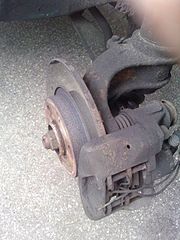Floating caliper brake
Floating caliper brakes are a type of disc brake . They are mainly used in automobiles . The floating caliper brake differs from the fixed caliper brake in that it works with only one brake piston , from which the movement of both the inner and outer brake pads is derived. This type of brake requires little installation space, has a high degree of efficiency , and is simple to build and maintain . Due to the more open design in contrast to the fixed calliper brake, the brake pads can usually be replaced more easily because the pad guides are less dirty.
With the floating caliper brake , only the lining guide is firmly connected to the wheel suspension , the brake cylinder can be moved transversely ("floating", hence the name). When the brake is actuated , the brake piston presses on the brake lining on one side of the brake disc. The cylinder housing relies with the back of a likewise floating frame from which embraces the brake disc side, while the second pad from the other side against the disk presses ( floating frame brake ).
From around the mid-1980s, a further simplification of the design prevailed, which in the meantime has almost completely displaced the floating frame brake : in the so-called floating caliper brake , the cast housing of the brake cylinder has a shape that surrounds the brake disc above the brake pads and like the pad on the opposite side pulls the fingers of a half-closed fist (hence the name) against the brake disc. In this way, the additional part of the floating frame and the guidance of the frame are saved, with the advantage that the brake works even more reliably because the additional guidance is omitted.
Individual evidence
- ↑ Floating frame brake. kfz-tech.de
- ↑ floating caliper brake. kfz-tech.de
